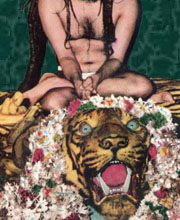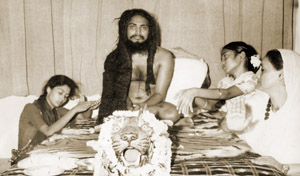 Bhava Samadhi
Bhava Samadhi
a Description
Bhava and bhava samadhi have to do with the spirit and the spirit is something the mind has difficulty explaining, or even admitting its existence. Yet spirit is simply consciousness. Spirit means forms of consciousness which we ordinarily never see.
Words cannot define spirit or its manifestations through bhava. But we try anyway.
The term bhava implies a mood or an attitude of mind. When used in the context of spiritual practices, it connotes spiritual moods or attitudes.
Bhava has a more narrow meaning in the context of Shivabalayogi's work. It refers to ecstatic states of consciousness evoked by the astral presence of higher beings. As Swamiji described, "Higher souls induce it." More specifically, “During the bhajans, when you get astral bodies and bhava, Swamiji has astral bodies in them.”
Bhajans are songs in praise of the divine; spiritual song. Bhajans are lively music with devotional lyrics addressed to the many aspects of God. (In north India, they refer to kirtan more often than bhajans) Shivabalayogi's public programs consisted of an hour of meditation followed by an hour of bhajans. The purpose for the bhajans is to evoke bhava.
“The same things happened during the time of Christ. Christ started teaching this type of meditation. He also employed astral bodies to induce bhava samadhi during bhajans.”
The astral presence of yogis and gods is unseen, but the outward appearance of people in bhava can be quite obvious. They begin moving, dancing, strutting, prancing, or playing. Sometimes they are made to speak. It depends upon the god and the circumstances. A person in the powerful trance of Hanuman, the god in the form of a monkey, climbs trees and breaks coconuts effortlessly. A person in the trance of Nataraja, Shiva in the form of the Cosmic Dancer, moves and dances gracefully. A person in the trance of Devi, the Divine Mother, is often in a very powerful trance. People in trance may simply sit in a lotus position, drawn into deep samadhi meditation. Trances of Buddha and Jesus were seen in this way. A person in the trance of Lord Krishna may be seen playing an invisible flute. The gods can be very playful, and it helps to remember that Swamiji himself is quite playful in addition to being powerfully awesome.
The person's mind may be a passive witness as his or her body is moved by the spirit. In a deeper trance, the person is no longer aware of physical surroundings. Some are transported to any number of different worlds. We might call such a world heaven, and when ordinary awareness is subsumed, we tend to label the bhava phenomenon as bhava samadhi. But there is no sharp distinction. Those who experience bhava describe the experience as always different. They also say that the experience never really leaves them.
The presence of astral bodies of gods and yogis is facilitated by spiritual song, but spirit is not confined to ecstatic music. Pretty much any action of a higher being is bhava. The gift of Shivabalayogi's power to meditate, given at initiation, is a manifestation of bhava. Those disciples who received Shivabalayogi's initiation into tapas — among them Kodangi Swami, Shrungavriksham Swami, and Seenu Baba (now known as Shivarudrabalayogi) — were able to meditate in samadhi only because Swamiji's astral body was in them doing most of the work. Swamiji regularly assured devotees that if they invested ten percent of the effort to meditate, he would do the other ninety percent.
Swamiji once explained that when he was fourteen-year-old Sathyaraju and his divine guru initiated him into tapas, that, too, was bhava samadhi. Because Shivabalayogi had completed tapas in so many other lives, Sathyaraju was immediately able to maintain samadhi on his own. But the initiation itself was through bhava samadhi.
The benefits of bhava are many and varied. Diseases, including chronic diseases, are cured. God-consciousness is instilled. The ego sense is subdued and is replaced by a spirit of self surrender to the will of God. Pain and misery, due to mental or physical causes, are removed. An absolute and implicit faith in God is instilled.
![]()
Left, Top to Bottom: Nataraja (Shiva the Cosmic Dancer) bhava — Nagaraja (King of Cobras) bhava — meditation in bhava — Krishna bhava — Hanuman bhava — Devi (Goddess) bhava — Shiva-Parvati bhava.
![]()
“Swamiji has done tapas for twelve years. He understands this subject. If you want to know this subject, come to Swamiji, sit down for twelve years and do tapas. Then you can understand, but not otherwise.”

